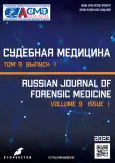Морфологические изменения в яичках белых крыс и человека при острой и хронической алкогольной интоксикации: экспериментальное и секционное исследование
- Авторы: Бабанин А.А.1,2, Уланов В.С.1,2
-
Учреждения:
- Крымский федеральный университет имени В.И. Вернадского
- Медицинская академия имени С.И. Георгиевского
- Выпуск: Том 9, № 1 (2023)
- Страницы: 19-27
- Раздел: Оригинальные исследования
- URL: https://journals.rcsi.science/2411-8729/article/view/133081
- DOI: https://doi.org/10.17816/fm729
- ID: 133081
Цитировать
Полный текст
Аннотация
Обоснование. Особый интерес представляет изучение влияния этилового алкоголя и наркотических веществ на репродуктивный аппарат мужчин. Практически отсутствуют исследования морфологических преобразований в яичках при алкогольных интоксикациях, что при современном уровне потребления этанола мужским населением репродуктивного возраста является не только медицинской, но и социальной проблемой, далёкой от своего решения.
Цель исследования ― изучить в ходе острого и хронического эксперимента выраженность и динамику морфологических изменений в гонадах при алкогольной интоксикации у половозрелых крыс и сравнить с таковыми у лиц с выраженным алкогольным катамнезом, умерших от одной из форм алкогольной болезни.
Материалы и методы. Материалом для проведения исследования послужили яички половозрелых крыс, которые подвергались острой и хронической интоксикации алкоголем (от 2 нед до 6 мес), а также яички лиц умерших с алкогольным катамнезом, в крови которых обнаруживался этиловый спирт (не менее 5 промилле).
Результаты. Как в экспериментальном, так и секционном материале строма тестикул характеризовалась выраженными циркуляторными расстройствами с полнокровием и стазом в посткапиллярах и мелких венах, отёком, явлениями периваскулярного и интерстициального склероза. Угнетение сперматогенеза в секционном материале было более выраженным и свидетельствовало о том, что именно алкоголь является основным этиопатологическим фактором обнаруженных изменений.
Заключение. Хроническая алкогольная интоксикация проявляется в виде повреждающего эффекта как напрямую, с изменениями стромы и паренхимы яичка, так и опосредованно на вышележащие звенья репродуктивной суперсистемы (гипоталамус и гипофиз). Нейротоксические, микроангиопатические и дисэнергетические эффекты этанола тормозят нормальный сперматогенез. В конечном итоге, негативное действие алкоголя, с позиций морфологического анализа, здесь реализуется в виде гипотестикулярных состояний, морфологическими проявлениями синдрома истощения яичка.
Ключевые слова
Полный текст
Открыть статью на сайте журналаОб авторах
Анатолий Андреевич Бабанин
Крымский федеральный университет имени В.И. Вернадского; Медицинская академия имени С.И. Георгиевского
Email: anatolij.babanin@inbox.ru
ORCID iD: 0000-0002-8907-6655
SPIN-код: 7045-4281
д.м.н.
Россия, СимферопольВладимир Сергеевич Уланов
Крымский федеральный университет имени В.И. Вернадского; Медицинская академия имени С.И. Георгиевского
Автор, ответственный за переписку.
Email: ylyan4ik@mail.ru
ORCID iD: 0000-0002-4096-2787
SPIN-код: 9556-7520
к.м.н., доцент
Россия, СимферопольСписок литературы
- Пиголкин Ю.И., Морозов Ю.Е., Мамедов В.К. Судебно-медицинская диагностика острой и хронической алкогольной интоксикации // Судебно-медицинская экспертиза. 2012. Т. 55, № 1. С. 30–33.
- Пиголкин Ю.И., Должанский О.В., Мамсурова Т.С., Чертовских А.А. Судебно-медицинская диагностика хронической алкогольной интоксикации по гистологическим изменениям мягких тканей полости рта и слюнных желез // Судебно-медицинская экспертиза. 2011. Т. 54, № 3. С. 10–12.
- Пиголкин Ю.И., Гасанов А.Б. Сравнительная морфологическая характеристика иммунной недостаточности при опиатной наркомании и хронической алкогольной интоксикации // Судебно-медицинская экспертиза. 2010. Т. 53, № 1. С. 26–29.
- Богомолов Д.В., Пиголкин Ю.И., Пешкова И.А., и др. Патоморфологические проявления различных форм алкогольной болезни // Архив патологии. 2003. Т. 65, № 4. С. 28–32.
- Mima M., Greenwald D., Ohlander S. Environmental toxins and male // Current Urology Reports. 2018.Vol. 19, N 7. Р. 50. doi: 10.1007/s11934-018-0804-1
- United Nations Office on Drugs and Crime [интернет]. World Drug Report 2020. Режим доступа:https://www.unodc.org/unodc/site-search.html?q=World+Drug+Report+2020. Дата обращения: 15.12.2022.
- Морозов Ю.Е., Породенко В.А., Травенко Е.Н., Горностаев Д.В. Морфологические маркеры функциональной активности печени при алкогольной интоксикации // Судебно-медицинская экспертиза. 2019. Т. 62, № 3. С. 37–41. doi: 10.17116/sudmed20196203137
- Соловьев А.Г. Использование крыс при моделировании алкогольобусловленной органопатологии: методические рекомендации. Архангельск: Архангельская государственная медицинская академия, 1997. 15 с.
Дополнительные файлы











